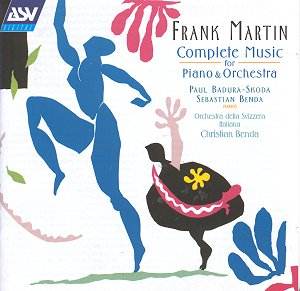Martin was no revolutionary yet his music has a hard-won
individuality that requires persistence. In some ways he is rather like
Rubbra. For Martin, as for his English contemporary, there is no glamour
- instead we find rather a sturdy passion. There is some solo piano
music, a little chamber music (which includes his easy winner the Trio
on Irish Folk Songs - you can hear it on Chandos CHAN9016), at least
one opera (on Shakespeare's Tempest), several large choral works
and many orchestral pieces with a special leaning towards the Concerto.
It is the concertante vein that is surveyed in this tidy release.
The Ballade's hesitant bluesy indeterminacy
alternates with the sort of high octane propulsion found in the Ravel
G minor. I can imagine Michelangeli or the young Leonard Bernstein making
a feast of this; not that Badura-Skoda is anything other than the heart
of brilliance. Shostakovich passes in gaudy sustained rhythmic buzz
in the last five minutes of the work. The clean strength of the recording
is comparable with ASV's wonderfully recorded Linz/Richter Korngold
orchestral anthology. The music is not atonal but tonality is allowed
slews and swerves. This liberation is even more evident in the Danse
de la Peur. Martin dabbled with twelve tones from early 1930s onwards
This piece was played by Dinu and Madeleine Lipatti in Geneva in 1944.
A stylistic map of the work might well include direction signs towards:
Bartók and de Falla. In fact, through the work's sepia half-tints,
vividness and verve we glimpse Nights in the Gardens of Spain and
Liszt's Totentanz. Sebastian Benda, who joins Badura-Skoda for
the Danse, has recorded the complete solo piano works of Frank
Martin.
The two piano concertos are separated by thirty-five
years. Martin poured into the first movement of the First Concerto
a ferocious virtuosity tougher than that found in the Ballade.
This is rather like Prokofiev through a fine gauge twelve -tone strainer
or comparable with Stravinsky's concerto for piano and woodwind. The
Allegro molto finale is a phantasmal call to arms played lickety-split
with gallop, scurry and skitter. The midpoint of the work is a Largo
with a lyrical cor anglais song suggesting singing sunk fathoms deep.
The Second Concerto is likely to be known to some collectors
from its issues as a Candide LP or a Swiss CD. It was written for Badura-Skoda
and . It is designed to be part symphony and part piano concerto. The
with virtuosity is in the Lisztian tradition which also speaks from
the inky brilliance of the finale. Note the ruffian suaveness of the
saxophone at 1.50. The core Lento makes much play of hooded scalar
writing recalling Koppel and Niels Viggo Bentzon. From this emerges
the image of a fantastic steely bridge spanning the sky.
There is no competition for this issue. This is the
only such collection of the complete music for piano and orchestra.
Not music to make blitzkrieg conquests but works of sincere substance
and curtained darkened brilliance.
Rob Barnett
